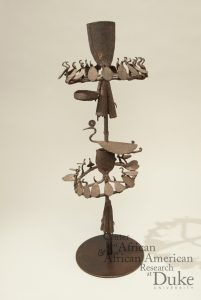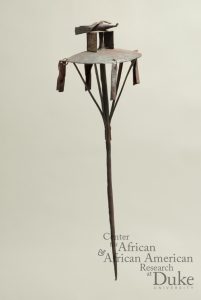Jamie Bottino
Rel 095
11/6/17


There is more than what meets the eye; an old saying that resonated through my head as I entered the “Spirited Things” exhibit at the University of Vermont’s Fleming Museum for the first time. The exhibit features sacred artifacts and altars sourced from West African religion, as well as the various diasporas that resulted from the displacement of African peoples as early as the 16th century. Passing each display, I was captivated by the individual parts that define altars as a whole as well as the orientation of individual objects in the museum space. Each artistic representation possessed a degree of complexity that I had never before seen at such volume. As I skirted the corner to view the second half of the exhibit, I spotted one particular encased object that stood alone.
Labeled “Staff of Fate” (Opa Osun), this piece drew me in among other artifacts because of its isolated arrangement in the context of the museum. As I approached the object, I realized that it contained many rusted limbs hinting at its old age. After reading the provided label for the staff, I discovered that it was a product of iron craftsmanship with an exception to its restored base. The object appeared to have levels near the top and bottom that resemble two distinct rings. Lining the outside of each ring are many small iron sculpted birds that face the stalk of the staff. Between both of these rings, a larger iron sculpted bird faces outwards in a fashion that resembles guidance and leadership. The larger bird is also adorned with a circular head piece and wings that extend far beyond its body, qualities the lesser birds lack (Duke University 2015) The very top of the staff contains a conical shape attached to a tray that leads down below the upper-ring. Adjacent to the tray, 4 long and narrow rusted bells are fastened to the object, and this is symmetrically represented below the lower-ring as well.
My basic understanding of staffs and their representations from other cultural examples led me to wonder if the Opa Osun garnered a certain force that could be manipulated by those who managed it. If the Opa Osun is interpreted in this way, what powers can be transmitted by the staff and who guides this power? In my writing, I will explore the substance of the Opa Osun Staff in Yorubaland in addition to the function of staffs and their operators in the context of ancient Yoruba tradition. By investigating these questions about the nature of the Opa Osun, I hope to reveal a heightened perception of religious artifacts in West Africa and the New World.
West Africa is home to ancient Yorubaland, a civilization where kingdoms once flourished in a framework of revolutionary urbanization (Okediji 1997). Within these kingdoms, artistic representations of sculpture containing highly refined naturalistic elements prospered and became a vital part of the religious traditions of the Yoruba (Drewal, Pemberton, & Abiodun 1989). During this period, craftsmen became highly skilled in the creation of sculpture using metals such as copper, brass, and bronze. The Opa Osun Staff is an example of the refined craftsmanship that characterizes the artistic creations of Yoruba people. A time considered a period of enlightenment in West Africa ended with the Trans-Atlantic Slave Trade, resulting in various diaspora in the New World. Forcefully relocated to a foreign frontier, Yoruba traditionalists brought their religious devotions overseas and practiced them behind closed doors amidst the ruthless bearings of slave life (Okediji 1997). The Yoruba expressed an unprecedented level of hope despite grim realities in the New World. Resilience played a crucial role in preserving the artistic creations of the Yoruba, and the Opa Osun Staff is no exception.
Religious artistic creations and tools significant in Yoruba culture are surrounded by a concept known as ase. Ase is a foundational power that concerns the state of living and nonliving things such as a staff. The phenomenon of ase can also be understood as a self-pertaining spiritual force that contains traditional medicinal answers (Abiodun 2014). There are many aspects of ase, however the most relevant to the Opa Osun is the role of ase as an activation of religious objects so that they may function accordingly. Artwork in Yorubaland is charged with ase, as it allows the visual representation of the work to transcend what others believe art to do. For example, staffs wielded by priests in divination processes are used to implement ase in the context of the ceremony. By establishing ase with a staff similar to the Opa Osun, priests can manipulate the fate of those who seek aid in their lives (Abiodun 2014). This insight accounts for the alternative name of the Opa Osun in the blurb beside the object in the museum, “Staff of Fate”. Another instance of a staff acting as a functional body can be found in an ancient Yoruba verse. In the verse, a cripple is instantly liberated from his state by just one touch from a healing staff (Abiodun 2014). The Opa Osun acts as a healing tool by harnessing ase in these instances of staff function. It is important to note that both scenarios of staff function detail that the operators of the staff have a higher status than a common individual.
The Opa Osun has also been used as a weapon against destructive forces such as death. In a ceremony referred to as Itefa, a religious leader known as a babalawo sacrifices a cock and uses the staff to arrange the body of the sacrifice. The ceremony involves the dismemberment of the animal, beginning with a swift ending of the cock’s life to ensure that death receives the offering instantly. Attending participants are touched on their heads with the head of the cock before it is then placed on the Opa Osun Staff. Following this, the babalawo takes the wings and feet of the sacrificed cock and touches them to the shoulders and feet of the ceremony’s participants before once again arranging them on the staff (Drewal & Thompson 1989). By doing so, a babalawo satisfies death with a cock in place of the members in attendance. The Opa Osun acts as a deterrent of future destruction in this case because the sacrifice of the cock ensures resilience against harm in the lives of the participants as well as the lone babalawo (Drewal & Thompson 1989). The Opa Osun can only be guided in this practice because its power cannot be entirely harnessed by the senior official. In other words, the staff is operated through influences, not direct actions.
The Opa Osun is demonstrated as an object that traditionalists look to for guidance in the present and future. In Yoruba culture, staffs are in fact charged with forces that can be manipulated by practitioners. Ancient verses and ceremonial divination allows me to suspect that the superior life force of ase is potent in power staffs similar to the Opa Osun. These comparable staffs serve a purpose of healing individuals who require aid as well as determining fate. The Opa Osun is also a medium to satiate destructive forces that threaten the well-being of practitioners. The sacrificial systems employed during the Itefa ceremony are telling of a complex transmission involved in the staff’s function. Both cases of staff power manipulation allow me to deduce that staffs in Yoruba culture are able to function as force synthesizers.
Staff power was and still is significant to Yorubaland inhabitants, and the principles of staff function were carried over to the various New World diaspora that resulted from the slave trade. From dissecting the use of staffs and their significance to Yoruba tradition, it seems natural that they would be implemented in the New World. Staffs served the purpose of limiting destructive futures and healing, therefore they would be applicable to the daily routines of an oppressed slave. Resilience allowed the Yoruba to prevail through hardship, and the Opa Osun symbolizes the hope retained by those subjugated.
I think back to the day I first laid eyes on the Opa Osun. A simple visit to the Flemings Museum paired with a quick reading of the information on the artifact was not nearly enough to understand the full potential of the object. I approached the object as if was a museum piece, when in reality the object is a functional entity that plays a critical role in religion (Thompson 1993). My experience with this object is representative of a cultural disconnect between Black Atlantic religions and Western society. Accurate assessments of Yoruba culture can only be reached if one analyzes the traditions in question with a curious and open mind, aware that art is much more than just a visual representation.
The Opa Osun Staff was theorized to be a reciprocating object of power due to a preconceived notion of staffs in other cultures. I also questioned the individuals who guided the power of the staff and the operations that surrounded its functioning. Upon research, I gathered that the Opa Osun has the ability to manipulate power, specifically the fate and resilience of one’s life. I also validated the figures who guide the powers of the staff, those being senior officials such as a babalawo. My findings leave me with a heightened perception of African religious power objects and the crucial role of a iron crafted staff in the lives of Yoruba religious affiliates.
Bibliography
Abiodun, Rowland. Yoruba Art and Language: Seeking the African in African Art. Cambridge:
Cambridge University Press, 2014. doi:10.1017/CBO9781107239074.
Drewal, Margaret Thompson, and Henry John Drewal. “An Ifa Diviner’s Shrine in
Ijebuland.” African Arts 16, no. 2 (1983): 61-100. doi:10.2307/3335852.
Okediji, Moyo. “Art of the Yoruba.” Art Institute of Chicago Museum Studies 23, no. 2 (1997):
165-98. doi:10.2307/4104382.
“Opa Osun, D027.” The Sacred Arts of the Black Atlantic. Accessed October 30, 2017.
http://sacredart.caaar.duke.edu/.
Opa Osun. 2015. The Sacred Arts of the Black Atlantic, Duke University, Durham.
Thompson, Robert Farris. Face of the gods: the artists and their altars. 1st ed. Vol. 28. Museum
for African Art, 1993.